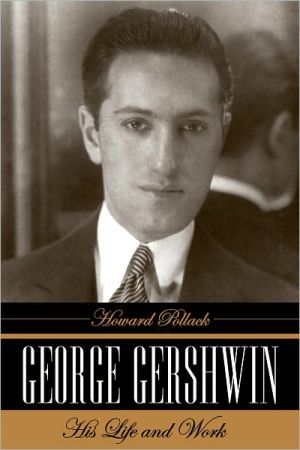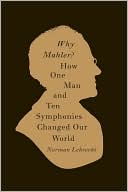George Gershwin: His Life and Work
This comprehensive biography of George Gershwin (1898-1937) unravels the myths surrounding one of America's most celebrated composers and establishes the enduring value of his music. Gershwin created some of the most beloved music of the twentieth century and, along with Jerome Kern, Irving Berlin, and Cole Porter, helped make the golden age of Broadway golden. Howard Pollack draws from a wealth of sketches, manuscripts, letters, interviews, books, articles, recordings, films, and other...
Search in google:
"Filled with new and revelatory information, Howard Pollack's fascinating and meticulous book is the closest anyone has come to capturing the essence of Gershwin's life and work"—Michael Feinstein, Grammy Nominated Singer-Songwriter"The scholarship and breadth of coverage are remarkable. This outstanding work should become the first port of call for any future study of Gershwin's life and works."—Andrew Lamb, author of 150 Years of Popular Musical Theatre and Leslie Stuart, Composer of Florodora"Brilliantly researched. Howard Pollack has written the most comprehensive survey of Gershwin's music."—Robert Kimball, editor, The Complete Lyrics of Ira Gershwin The New York Times - Peter Keepnews This is surely the closest reading Gershwin s music has ever received. Rhapsody in Blue and the other concert pieces get scrupulous attention, of course, generally admiring if not entirely uncritical. So does Porgy and Bess, Gershwin s only full-length opera, which Pollack examines in four tour-de-force chapters from every conceivable angle, racial and social as well as musical, beginning with the work s genesis and ending with a brief but intelligent survey of the many jazz and pop versions of its score. But unlike previous biographers, he takes a microscopic look at everything Gershwin wrote, or at least everything that survives.
Contents PrefacePART I. LIFE1. Gershwin and His Family 2. Gershwin's Musical Education to the Rhapsody in Blue (1924)3. Gershwin and the New Popular Music4. The Popular Pianist5. Toward a Career in the Theater6. Gershwin among His Friends7. Later Studies8. Gershwin and the Great Tradition9. Gershwin and Popular Music and Jazz after 192010. Working Methods11. Gershwin the ManPART II. WORK12. From "Ragging the Traumerei" (ca. 1913) to The Capitol Revue (1919)13. From Morris Gest's Midnight Whirl (1919) to The Perfect Fool (1921)14. From The French Doll to Our Nell (1922)15. From The Sunshine Trail to Sweet Little Devil (1923)16. The Rhapsody in Blue (1924)17. The Scandals of 1924, Primrose, and Lady, Be Good! (1924)18. Short Story, Tell Me More, and the Concerto in F (1925)19. Tip-Toes and Song of the Flame (1925)20. Oh, Kay! and Other Works (1926)21. Strike Up the Band and Funny Face (1927)22. Rosalie and Treasure Girl (1928)23. An American in Paris (1928) and East Is West (1929)24. Show Girl and The Dybbuk (1929)25. Girl Crazy (1930)26. Delicious and the Second Rhapsody (1931)27. Of Thee I Sing (1931)28. George Gershwin's Song-Book (1932)29. The Cuban Overture (1932) and Pardon My English (1933)30. Let 'Em Eat Cake (1933) and Variations on "I Got Rhythm" (1934)31. Porgy and Bess (1935)32. The First Production of Porgy and Bess33. Porgy and Bess in Revival34. Porgy and Bess on Disc, Film, and the Concert Stage35. From Swing Is King (1936) to A Damsel in Distress (1937)36. From The Goldwyn Follies (1938) to Kiss Me, Stupid (1964)Conclusion Notes Selected Bibliography Index
\ From the Publisher"Pollack presents a fresh stance on the legendary composer in a monumental biography. . . . A fascinating narrative of Gershwin's life."—Opera Journal\ \ \ \ \ Peter KeepnewsThis is surely the closest reading Gershwin’s music has ever received. “Rhapsody in Blue” and the other concert pieces get scrupulous attention, of course, generally admiring if not entirely uncritical. So does “Porgy and Bess,” Gershwin’s only full-length opera, which Pollack examines in four tour-de-force chapters from every conceivable angle, racial and social as well as musical, beginning with the work’s genesis and ending with a brief but intelligent survey of the many jazz and pop versions of its score. But unlike previous biographers, he takes a microscopic look at everything Gershwin wrote, or at least everything that survives.\ — The New York Times\ \ \ Publishers WeeklyUniversity of Houston music professor Pollack (Aaron Copland: The Life and Work of an Uncommon Man) offers a look at Gershwin so exhaustive and comprehensive that it stands as a definitive statement. Bibliographic notes filling 100 pages indicate the extent of this in-depth re-examination. Scholarly yet entertaining, Pollack's survey is not chronological; it's divided into two book-length sections. In part one, a study of popular music trends serves as an overture to Gershwin's musical influences, his childhood and Tin Pan Alley years, followed by a look at Gershwin as a pianist and conductor through his death from a brain tumor at the age of 38. The book's second half, titled "Work,'' is an ambitious attempt to document Gershwin's entire output, from orchestral works to theater, radio and films, including the role of lyricist Ira Gershwin in reworking his brother's tunes, as he did for Billy Wilder's 1964 film Kiss Me, Stupid. The creation of Porgy and Bess and subsequent revivals, films, concerts, recordings and jazz interpretations (notably by Miles Davis) fill several chapters with fascinating details. Gershwin's innovative synthesis of classical, blues and jazz into a "glorious body of work" is illuminated by Pollack's insightful analysis. 51 b&w photos. (Dec.) Copyright 2006 Reed Business Information.\ \ \ \ \ Library JournalPollack (music, Univ. of Houston; Aaron Copland: The Life and Work of an Uncommon Man) here turns his attention to another American composer, George Gershwin (1898-1937). While he lacks the firsthand knowledge of which many previous biographers boasted, e.g., David Ewen in A Journey to Greatness: The Life and Music of George Gershwin (1956), Pollack has the advantage of perspective and new materials discovered in a warehouse in 1982. The book is organized into two broad sections: "Life" presents a balanced treatment of important events and people, including Gershwin's mother; "Work" tackles the whole of Gershwin's oeuvre, beginning with "Ragging the Traumerei" in 1913 and ending with the music he wrote for The Goldwyn Follies shortly before he died in 1937. Pollack treats Gershwin as primarily a composer for the theater and therefore focuses on the many forms theater music may assume. There are synopses of the stories for each of Gershwin's shows, many of which cannot be found elsewhere. The depth of detail and research into Gershwin's works (more than 100 pages of endnotes) makes this an essential purchase for all libraries and one of the best books available on Gershwin. Bruce R. Schueneman, Texas A&M Univ. Lib., Kingsville Copyright 2006 Reed Business Information.\ \








